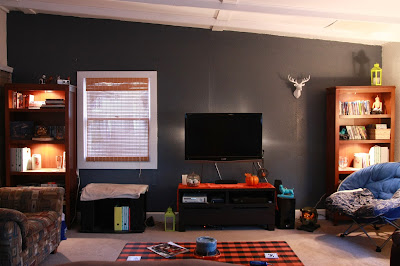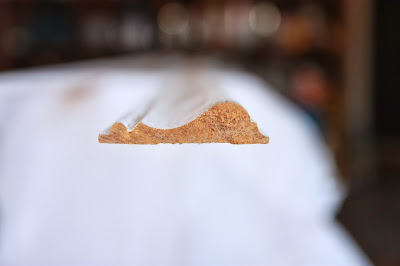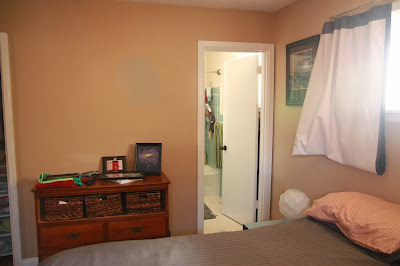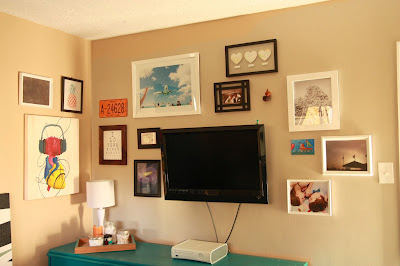What really secured his purchase was the price. I have seen a lot of these stag heads floating around decor boards and magazines and I always liked the look. The ones I like are ceramic and come with a pretty decent price tag. For instance, on Amazon, you can get a stag head around the same size.
$44.99 is a fortune compared to the little fuzzy guy I picked up.
That's right. $9.99! He is plastic, but it's a pretty durable and thick plastic, so I felt like he would be pretty easy to work with. To start, though, I had to get off his fuzzy exterior.
For some reason, my mind immediately said, 'Oh, I know what to use."
That's right. More uses for liquid sander and deglosser! To be sure that I wasn't making a huge mistake, I first put a dab on the back where the head is mounted and let it sit for about 20 minutes. Then I just wiped it off and the fur came right up with it.
After I knew that my efforts wouldn't be in vain, I started out at the end of one of the antlers. I just soaked half the antler in the deglosser and let it sit for another 30 minutes, then came by and wiped the fuzzy stuff off. In some parts, I ended up using my nail to scrape at the fur, but doing so didn't damage the plastic. Also, don't judge my beginning set up. The bag of chips was empty and I needed something that the deglosser wouldn't eat through!
I eventually found a lid to an aluminum tray that we had used earlier and ended up moving over to that.
As I worked, I also used an old sponge to keep soaking the fur in the deglosser. Here you can see where I let the face soak. Each time, I left it on for around 30 minutes. I just had it set up in the living room and I would work on scraping and resoaking it between shows.
It looked kind of cool and semi-realistic with just the antler exposed, but that wasn't the look I was personally going for. I wanted something more like this.
I loved how the white contrasts with the darker walls, and I knew I wanted to have this as part of a frame wall around our TV in the living room. The dark blue wall behind it would really make it pop.
When I had finished taking off all of the fuzzies, I gave it a good scrub down with a toothbrush and let it dry. A lot of detail that was hidden under the fur emerged, which was a great surprise. So far, he wasn't looking too bad!
Then, I used Rustoleum Primer to give the glossy white paint a good base. I started on the back so that if there was any tacky paint left when I went to flip it over, it would stick to the back, not the front.
Then, once both sides were primed, I gave it two coats of Rustoleum glossy white (again, starting from the back). I chose glossy because I want it to look as ceramic as possible. It actually does a really good job of making plastic look a little 'higher class'.
Because it decided to be really cold outside, I took a board and placed it underneath the drop cloth. After I finished a coat, I would bring it inside to dry. That way it was actually warm enough to cure.
When he was finished, I mounted him on the wall near the TV.
For now he looks a little lonely, but the final product will look a little closer to this, with large picture frames surrounding the TV.
He is probably one of my favorite hanging things in the house right now, though. He even has a little smirk on his face!
So, that's how I managed to make a $50 stag head for $10. Super simple, just make sure you run out to Garden Ridge soon or you might not get one. Ours only had 2 left as of Monday. There are so many different ways you can paint them (gold/silver antlers, matte black, fun teal or pink) and I can't wait to put a scarf on him for the winter months! What a party animal!
After I knew that my efforts wouldn't be in vain, I started out at the end of one of the antlers. I just soaked half the antler in the deglosser and let it sit for another 30 minutes, then came by and wiped the fuzzy stuff off. In some parts, I ended up using my nail to scrape at the fur, but doing so didn't damage the plastic. Also, don't judge my beginning set up. The bag of chips was empty and I needed something that the deglosser wouldn't eat through!
As I worked, I also used an old sponge to keep soaking the fur in the deglosser. Here you can see where I let the face soak. Each time, I left it on for around 30 minutes. I just had it set up in the living room and I would work on scraping and resoaking it between shows.
When I had finished taking off all of the fuzzies, I gave it a good scrub down with a toothbrush and let it dry. A lot of detail that was hidden under the fur emerged, which was a great surprise. So far, he wasn't looking too bad!
When he was finished, I mounted him on the wall near the TV.





























































